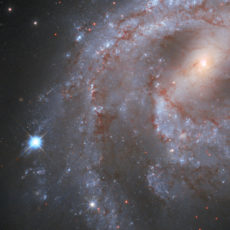
NASA’s Hubble Space Telescope captured a brilliant image that shows a section of the spiral galaxy called ‘The Needle’s Eye,’ a dwarf spiral galaxy. It is also known as NGC 247 or Caldwell 62 and located approximately 11 million light-years away in the Sculptor Group, which just so happens to be the closest group of galaxies to our own. This galaxy received its nickname due to it featuring a bizarre void of stars.

What you’re seeing here is the very edge of the galaxy, opposite of the void. Look below the edge of the galaxy’s disk, and you’ll discover smaller, more distant galaxies as well as a very bright foreground star that lies between the Local Group (our galaxy group) and NGC 247. The bright red shows areas of high-density gas / dust and heavy star formation rather close to the edge of the galaxy. In the far (or near) future, humans may actually be able to witness a spiral galaxy collision from a spacecraft.
- POWERFUL TELESCOPE FOR ASTRONOMY BEGINNERS: The Celestron AstroMaster 130EQ Newtonian reflector is ideal the telescope for beginners. It features...
- NEWTONIAN REFLECTOR OPTICAL DESIGN: With a large, 130mm aperture, the AstroMaster 130EQ can gather enough light to see our Solar System and beyond....
- EASY TO SET UP AND USE: This is a great telescope for kids and adults to use together. It features a manual German Equatorial mount for smooth and...
Caldwell 62 is also home to an object known as an ultraluminous X-ray source. Scientists have long debated the nature of these super-bright X-ray sources. Are they stellar-mass black holes gorging on unusually large amounts of gas? By studying Caldwell 62 in multiple forms of light (visible and infrared using Hubble, and X-rays using the Chandra X-ray Observatory), astronomers have found signs that the X-rays are coming from a disk around an intermediate-mass black hole,” said NASA.






